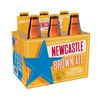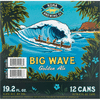Grocery Guides
Ales – All You Need to Know | Instacart’s Guide to Groceries

What are ales?
Ales are a popular type of beer enjoyed all over the world. They’re different from lagers (the other major category of beers) because they’re brewed at a higher temperature. The result is a more alcoholic beer that tastes somewhat sweet and has a full body.
There are dozens of ales and hundreds—if not thousands—of ale brewers in every continent. Thus, ales are as varied and diverse as you can imagine, with flavors ranging from fruity to nutty to chocolaty. They can also be light-, caramel-, or dark-colored.
Ales are often served at room temperature to allow their flavorful notes to shine through. They can be poured in many ways, usually depending on the preferences of the drinker or bartender. This means you can have a pint with a wide layer of creamy foam on top or not.
Where did ales originate?
Humans have been making and drinking ale for at least 5,000 years. There were ale breweries worldwide, including in ancient China, Egypt, Iran, and Europe. Small-scale brewers created their own regional recipes and sold them to their neighbors and in markets. In Europe, ale was such a popular drink during the middle ages that adults and children drank it as much as they did water.
Industrial-scale ale brewing only took off in the 17th century, during the Industrial Revolutions. Brewers could now make large quantities of ale beers in a very standardized way and ship them everywhere.
Today, we are still drinking as much beer as back then. Small artisanal batches of ale are now gaining popularity and challenging large brands. Brewers are trying out new flavor combinations to stand out from the competition.
How are ales made?
All ales are made a little differently. Yet, the brewing process tends to follow these basic, simplified steps.
Brewers prepare wort from a mixture of grains. Which grain they pick affects the color, flavor, and texture of the ale. Ales are often made from barley, rye, or wheat, though many other grains can be used.
Once the wort has been extracted and cooled, it’s time for the next step. A specific type of yeast (called Saccharomyces cerevisiae) is added to the wort and left to ferment at a temperature between 60-75ºF. The yeast settles at the top of the drink, which is what makes ale different from lagers. During this process, the yeast converts the sugars in the wort into alcohol and carbon dioxide.
After a few days of maturation, the wort has now fully transformed into beer. Brewers bottle and label the ale and ship it to supermarkets and liquor stores across the world.
What should I look for when buying ales?
When buying ales, you need to know what type of beer to look for. These are some (but not all) of the ales you’re most likely to find at the store:
- Brown ale: This beer tastes nutty and mild.
- Pale ale: You’ll have no problem noticing the flavor of the hops and malt used in this ale.
- India Pale Ale (IPA): This ale is noticeably hoppy and generally stronger than pale ales.
- Golden ale: Served at cold temperatures, this ale mimics the taste and mouthfeel of lagers.
- Pilsner: Originally brewed in Central Europe, the pilsner is more bitter and crisper than other ales.
- Stout: Dark-colored, sweet, and barely bitter—this is a great introductory and easy-to-drink ale.
- Sour: This unique beer has more of an acquired taste, as it’s sharp and tart but also fruity.
If you are looking to have your groceries delivered, you can easily shop for ales via Instacart. After adding a product to your cart, use the “Instructions” option to notify your Instacart shopper about any preferences or specific directions on how to choose the best products. Shop for ales.
Grab it now on Instacart:







How to store ales
Ales aren’t like spirits. Because they have a low alcoholic content (usually under 10%), they won’t age, but they can spoil.
When you come home with a pack of ales, you can either store them in the fridge or at room temperature, in a cool and dry place away from direct sunlight. If you plan on drinking your ale within a month or two, you can do either. But if you want to keep them for longer, the fridge is the best place for them. In both cases, you should store your ales upright.
Do keep in mind that most craft beers in the United States are not pasteurized. Thus, they will go bad more quickly than the commercial ales such as Budweiser or Guinness.
How to tell if ales are bad
There are several ways of telling if your beer has gone bad.
For starters, it may not fizz up when you open the bottle. Secondly, you’ll notice that the beer’s aroma is off—it may smell like grass clippings, butter, and even corn. On top of that, you may also see dusty sediments at the bottom of the bottle.
If you find any of those signs in your beer, it’s best to dump it down the drain.
What can I substitute for ale?
A good substitute for ale is lager, the other major type of beer out there. Lagers are fermented with a different yeast at a lower temperature and have more fizz than ales. They also tend to be smoother and less flavorful, so they’re usually the place to start for anyone not used to drinking beer.
Find the best ales without leaving the house
You don’t need to leave your house to find the best ale for your taste. Now that you know what to look for when buying ales, you can pick the ones you like online through Instacart. With just a few clicks, you can get your alcohol with same-day delivery in under 2 hours. What could be more convenient than that?
Most Recent in Grocery Guides

Grocery Guides
19 Best Milk Substitutes for Baking and Cooking
Milk’s rich texture and neutral flavor make it a staple in countless recipes, bringing creaminess and balance to sweet and savory dishes alike. But what happens if you run out of milk or need a…
Jan 30, 2025
Grocery Guides
15 Best Cheeses for Your Next Charcuterie Board
Let’s face it: The heyday of the store-bought party platter is long gone. Now, the duties of a good host often include curating an impressive charcuterie board. But where do you begin? Charcuterie boards typically…
Jan 21, 2025
Grocery Guides
Guide to Movie Night Snack Delivery
Planning the perfect movie night means getting cozy, choosing a favorite film and gathering all the right treats. With movie night snack delivery, you can skip the hassle of a grocery run and have delicious…
Dec 19, 2024

 Squash – All You Need to Know | Instacart Guide to Fresh Produce
Squash – All You Need to Know | Instacart Guide to Fresh Produce  Ghost Pepper – All You Need to Know | Instacart Guide to Fresh Produce
Ghost Pepper – All You Need to Know | Instacart Guide to Fresh Produce  Sprouts – All You Need to Know | Instacart Guide to Fresh Produce
Sprouts – All You Need to Know | Instacart Guide to Fresh Produce 

